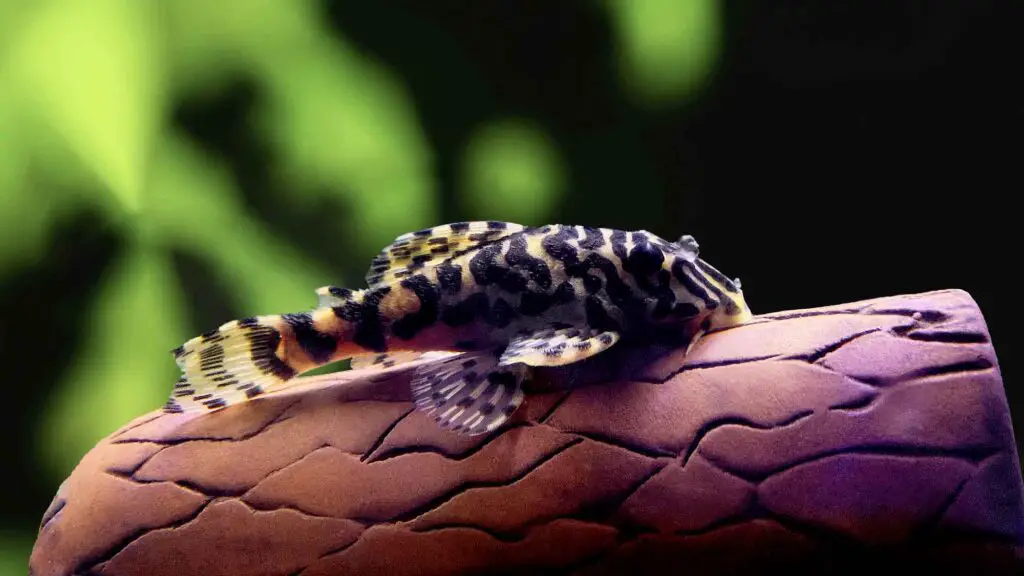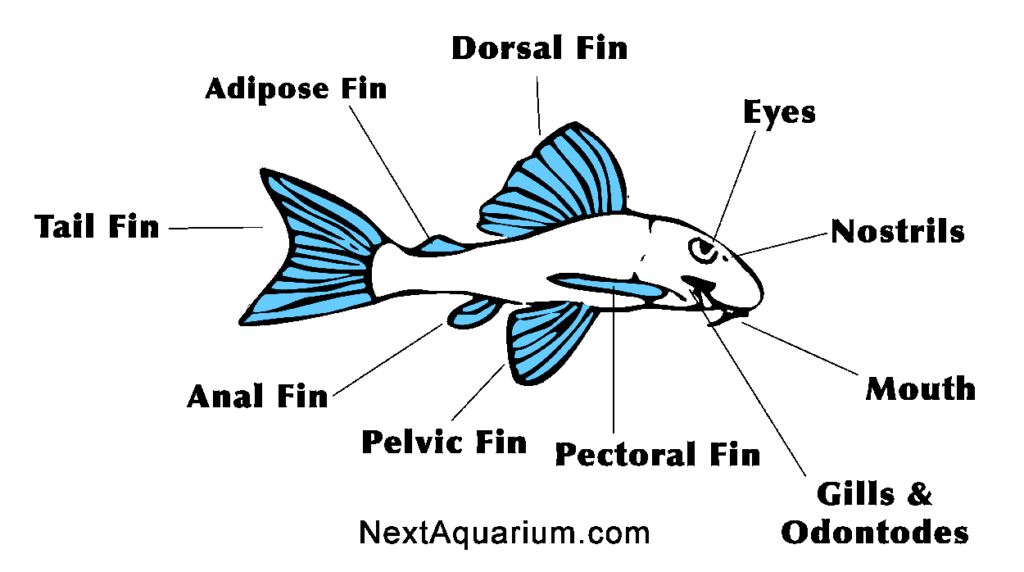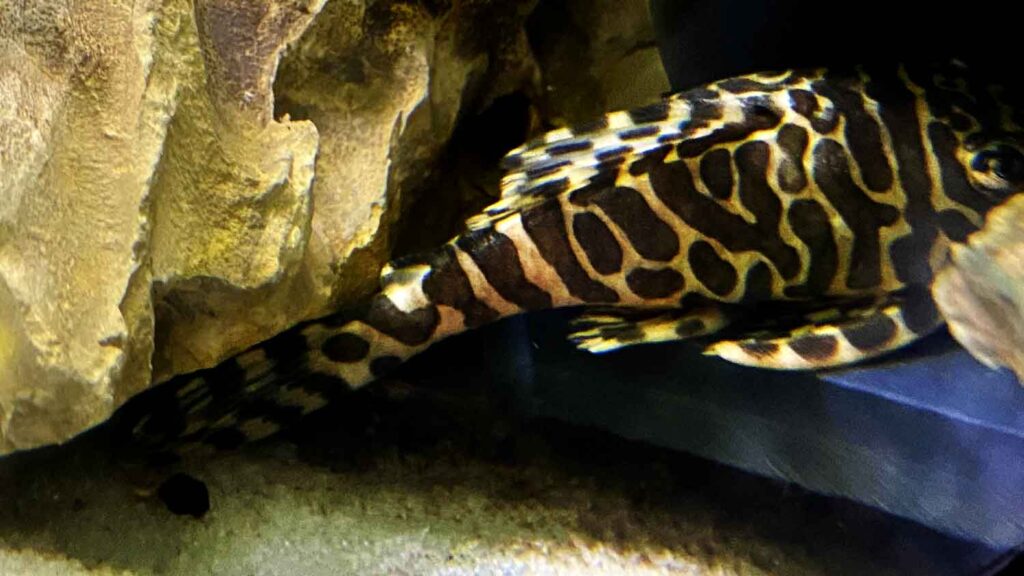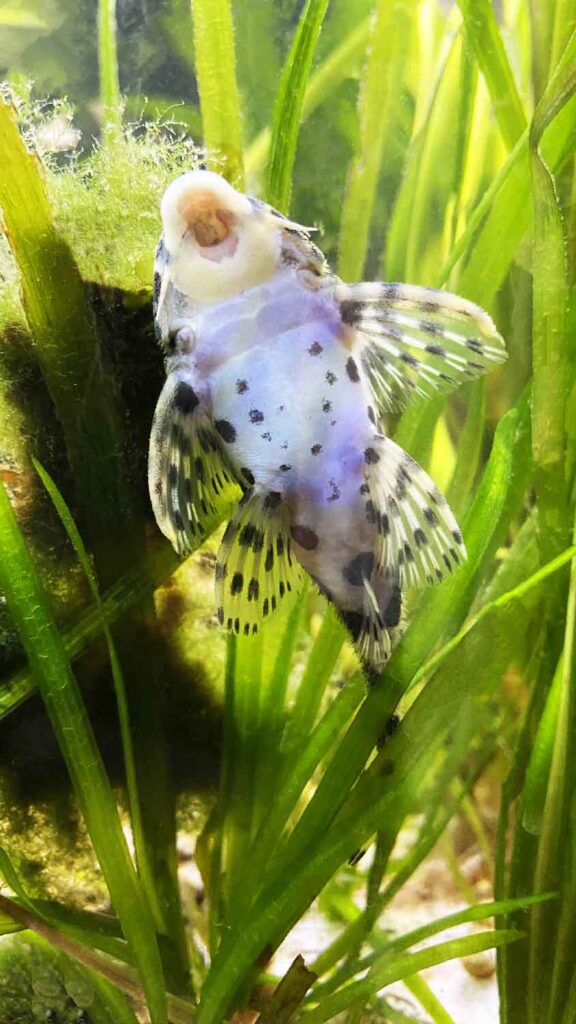The Leopard Frog Pleco (Peckoltia compta) is a gorgeous freshwater fish that is pretty famous among aquarium owners. This vivid and neat-looking fish will be the showpiece of the tank’s bottom area. These easy going peaceful fish won’t cause any issues or disturbance in the tank and will need low care.
This guide will walk you through all the necessary information about Leopard Frog Pleco and create an ideal environment for them in your tank. This guide will make you completely ready for ownership of this beautiful fish.
Species Profile & Overview
Leopard Frog Pleco (L134 Pleco) is a type of pleco that goes by a few additional names. You might see them referred to as the L134 or Leopard Frog Pleco or even their scientific name (Peckoltia compta). Their origin is the Rio Tapajós downstream from the confluence with Rio Jamanxim in Pars, Brazil.
Like all members of the Loricariidae family (Plecos), they have a cylinder shaped body that has an armored back. Their bony back will help them protect themselves from aquatic predators. Among fishkeepers, they are famous for their small size and unique patterns and coloration.
The majority of Leopard Frog Plecos that are sold in pet stores are wild-caught. This is because these fish need specific water conditions to breed. Fortunately, many fisheries and individual fish keepers are breeding these fish as well. This will stop the excessive collection of these fish from the wild which will help these fish to repopulate in nature.
Many misconceptions are spread online about L134. That might discourage some people from having these beautiful fish. We believe they are a great addition to any tank that has the right water parameters.
Appearance:

The L134 can be the jewel of your tank when they get proper diet and care. When they are not under stress and get the right food they will show absolutely beautiful markings that will grab anyone’s attention.
On the back of their body, the L134 has several rows of armor plates. These plates are hard and bony which will protect fish from predators. Their body is wide and thick at the head and slowly gets thinner toward the tail fin.

As you can see in the picture above, they have 8 fins across their body. Compared to the body, all their fins are large and slightly shaped backward. Fins are translucent but have the same pattern as the rest of the body.
The base coloration for L134 is yellow and is covered with black stripes. These black stripes cover the entire back of their body as well as the fins.
As the fish grow, the uniformed black stripes will slowly break and will create broken lines and dots on the fish.
Adult Size
When fully grown, the average Leopard Frog Pleco size is around 3.5 – 4.5 inches in length. This makes them an ideal pleco fish for most aquarists who want to keep a smaller pleco.
This is a very manageable size for most aquarium owners that want to keep a pleco in their smaller aquariums.
LifeSpan
L134 Leopard Frog Pleco lifespan is approximately 8 – 10 years. When conditions are right, they will live even longer.
This is an expected age but not a guaranteed age! To make them reach their expected life, you must provide them with the right water parameters and diet throughout their lifetime.

Behavior and Temperament
Leopard Frog Plecos are very friendly fish that will mostly mind their own business without causing any issues for other fish in the aquarium. During the day, they will mostly hide and prefer to scavenge for food at night.
That said, when they feel safe, they will come out of their hiding spot even during the daytime. If you have low light levels and no large aggressive fish are in the tank, they will come out during the day.
The male specimens of L134 Plecos are also known to show territorial behavior during the breeding season. This behavior can be towards other males or any other bottom-dwelling fish that comes near their cave.
If you notice any aggressive behaviors in the tank, you should simply create more hiding spaces and caves so each fish can claim a territory. Males need caves in the aquarium, so you will need to add a pleco cave for each male that you have in the tank. Removing some of the males from the tank is also another way to prevent aggression.
Leopard Frog Pleco Care
The good news is that Leopard Frog Pleco care is easy. They will need a few basic adjustments in the tank and they will thrive. However, the best approach to care for L134 is to create your tank environment as close to its natural habitat as possible. Diet is another important part, they will need a good mix diet that provides all the nutrition they need.
To create an ideal environment for your Leopard Frog Pleco you will need to follow the recommendations mentioned below.
Tank Size
The minimum tank size for a single Leopard Frog Pleco is a 20 gallons long or a 30 gallons regular aquarium. These fish are one of the smaller plecos, which makes it possible for aquarists to keep them in this size tank. However, large tanks will maintain more constant parameters compared to smaller ones so bigger aquariums are always better.
L134 plecos need more floor area than just water volume. The more surface area you provide them the happier they live. This is especially true when you house more than just one pleco. Bigger aquariums will naturally have a larger bottom area and also they maintain more stable parameters which is a plus point.
Ideally, a tank that is wide and long is much better than a high tank. This is because high tanks have less bottom area than low tanks that hold the same volume. They both might hold the same amount of water but the high tank can house fewer plecos as it has shorter width or length. To create even more bottom surfaces for your Leopard Frog Pleco, you can add slates and rock decorations to your tank.

Tank Setup:
When planning the tank setup for a Leopard Frog Pleco, it’s important to create an environment that is as close to this fish’s natural habitat as possible. They are very shy fish and will need lots of hiding spots to hide. Keeping plecos in a tank with no hiding spots will cause high levels of stress in the fish which will eventually lead to diseases that might cause death.
You can create hiding spots simply by placing many rocks and driftwoods in the aquarium. These fish will take refuge in the shades and crevasses created by the decorations when the light is on. There are also many pleco caves sold online that are specially manufactured for plecos. These caves provide a dark and secure space for the fish to rest during the daytime.
The L134 plecos have a soft belly and they spend the majority of their time at the bottom of the tank. Sharper substrates will hurt their soft abdomen and cause infection. Sand, small size pea gravels, and some of the planted tank substrates are the top 3 options you can use as substrate. Sand is the ideal substrate if you don’t have any root feeder plants in your aquarium.
For an ecosystem to be healthy, plants are a must. Aquatic plants will clean your tank of contaminants while also giving your fish lots of places to hide. We strongly advise using plants in your aquarium to improve its aesthetic and functionality.

Water Parameters:
in order to keep your Leopard Frog Pleco healthy and happy, you will need to simulate their natural habitat in your tank. These fish are hardy and might live in a wider range of parameters but they will only thrive when you match your tank to its natural environment. In the wild, these fish have warm and well-oxygenated waters that have low TDS. Below are the range you can keep L134 plecos in:
- Temperature: 75 – 86 Degrees Fahrenheit
- PH: 6 – 7.5
- TDS: 60 – 120 PPM
Keeping your tank in the range mentioned above will ensure your fish will live a happy life. As mentioned, stable water parameters are the key to the health of this fish. To maintain stability in your tank, we recommend buying a TDS (Total Dissolved Solids) meter. Every time your tank’s TDS crosses the ideal range you will need to change the water so the TDS goes back down.
Lighting:
With the right tank setup, Leopard Frog Pleco does not have specific lighting needs and can adapt to any lighting conditions in the aquarium. So it’s best to choose your light based on the types of plants you are keeping in the tank.
Filter System:
Leopard Frog Pleco, like most plecos, generates a considerable amount of waste. You will therefore need a powerful filter to ensure that the water in your tank is always clean. Because L134 plecos are extremely sensitive to ammonia spikes, you must use the most powerful filtering systems you can afford. Large filters are capable of handling waste and preventing ammonia levels from rising.
Common Diseases and Prevention
In an unbalanced aquarium, these fish will suffer and might get diseases or infections. Leopard Frog Pleco is one of the hardy fish in the aquarium hobby, but they live in a tiny space called an aquarium. In a small ecosystem like a fish tank, diseases will easily and rapidly transfer between fish.
Most diseases and infections are directly caused by low water quality and bad tank setup. To increase water quality you will need to have a strong filter that can handle the waste production. Along with a good filter, you will also need to change about 25 percent of the water every week. The Leopard Frog Pleco also needs a lot of hiding spots so it can feel safe. Doing this will let your fish have a clean and stress-free environment that will embrace its health.

Diet and Feeding Requirements
Leopard Frog Pleco are omnivores and will eat a variety of different types of fish food. You will need to feed them a mix of different plant-based foods and occasionally feed them frozen high-protein foods. You should make sure that your fish receive enough algae, plant matter, fresh vegetables, and other plant-based foods in their diet.
The primary type of food for L134 should be from plant matter and alga. but you will also need to provide a mix of different high-protein food types. The ideal protein sources can be bloodworms, brine shrimp, tubifex, daphnia, and other small creatures. You can buy these live or frozen from pet stores or online.
Many commercially made foods are specifically made for plecos. These prepared dry foods have the right ingredients that plecos need. When purchasing dry foods, it’s best to get multiple different types of sinking foods and feed your pleco a mix of all of them. This will let your fish receive all the nutrition it needs.
The Leopard Frog Pleco has a diverse diet in its natural habitat and will need a similar diet in captivity as well. Commercial foods should be the primary diet they receive and live foods can be a snack they get a few times a week. Most fish foods sold in stores only have a few of the ingredients plecos eat in the wild. So you will need to feed them a few different types of sinking foods so they get a balanced diet. Feeding should be done at night and only feed as much as they eat overnight.
Leopard Frog Pleco Breeding
Breeding Leopard Frog Pleco is a delicate and sometimes frustrating process. Breeding L134 can be done in aquariums when the conditions are right.
In order to breed these fish, you will need your L134 to be mature and at least 3 – 5 years old. Once you confirm you have at least one male and one female in your breeding group, you can start to condition your fish for breeding.
If you have more males in your tank, then make sure that each male has a cave available in the tank for them. The rule of thumb is to add at least one cave per each male if not more.
L134 are cave breeders which means they need caves to breed. The cave should be slightly bigger than the male’s body; but, small enough that he can trap the female inside.
For breeding purposes, the male looks around for a suitable cave to trap the female in. When the male finds a suitable cave, he will clean it out and wait for the female to arrive. The male will then trap the female and will not let her leave the cave until she lays eggs.
Leopard Frog Plecos lay about 25 – 40 eggs each time they breed.
Once eggs are laid, the male will let the female leave the cave, and then he will fertilize the eggs. It’s the male job to guard the eggs until they hatch. During this time, the male cleans the eggs and fans them so the eggs don’t go bad or get mold.
The eggs usually hatch 7-10 days after being laid.
After hatching, the fry usually stay at the back of the cave and feed on their egg sacks for the next few days. The male will keep the fry in the cave for another 7-10 days until they are fully developed and ready to leave.
Once the fry are strong enough, they will escape the cave and will attach to driftwood or glass in the aquarium. The fry usually stays together in a cluster in a single spot until they grow to half an inch in length.

Leopard Frog Pleco Tank Mates
Leopard Frog Pleco can become aggressive when they are in breeding season or if they don’t have enough space in the tank. They tend to fight over territory or their favorite hiding spot. However, when the tank has the right design and decorations your L134 will live peacefully with other fish of roughly the same size or smaller.
Leopard Frog Pleco will mostly rest in its favorite hiding spot or will be busy scavenging for food. So they will not cause any issues to other fish in the tank. That said, you should avoid adding any aggressive fish that might go after your pleco. Larger fish might also try to eat your L134 so they can’t make good tank mates. Fish that need different water parameters should be avoided as well. Here are some of the fish we believe can make a great tank mate for your Leopard Frog Pleco:
- Angelfish
- Dwarf Gourami
- Swordtail
- German Blue Ram
- Discus
- Hatchetfish
- Zebra Danio
- Tetras
- Other Plecos
Conclusion
Now that you’ve learned everything there is to know about Leopard Frog Pleco (L134) care and what this species requires to thrive, it’s time to decide whether you can house one or not. If you can provide the necessary care we highly recommend giving them a try. These fish are fun to watch and will make a great community fish.